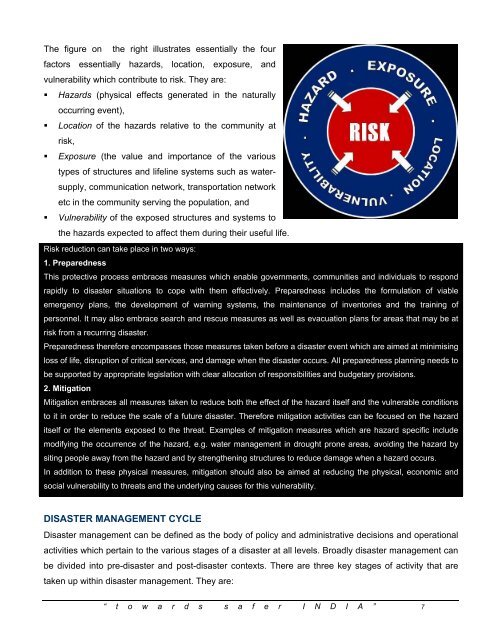Hazards, Disasters And Your Community - United Nations ...
Hazards, Disasters And Your Community - United Nations ...
Hazards, Disasters And Your Community - United Nations ...
Create successful ePaper yourself
Turn your PDF publications into a flip-book with our unique Google optimized e-Paper software.
The figure on the right illustrates essentially the four<br />
factors essentially hazards, location, exposure, and<br />
vulnerability which contribute to risk. They are:<br />
• <strong>Hazards</strong> (physical effects generated in the naturally<br />
occurring event),<br />
• Location of the hazards relative to the community at<br />
risk,<br />
• Exposure (the value and importance of the various<br />
types of structures and lifeline systems such as watersupply,<br />
communication network, transportation network<br />
etc in the community serving the population, and<br />
• Vulnerability of the exposed structures and systems to<br />
the hazards expected to affect them during their useful life.<br />
Risk reduction can take place in two ways:<br />
1. Preparedness<br />
This protective process embraces measures which enable governments, communities and individuals to respond<br />
rapidly to disaster situations to cope with them effectively. Preparedness includes the formulation of viable<br />
emergency plans, the development of warning systems, the maintenance of inventories and the training of<br />
personnel. It may also embrace search and rescue measures as well as evacuation plans for areas that may be at<br />
risk from a recurring disaster.<br />
Preparedness therefore encompasses those measures taken before a disaster event which are aimed at minimising<br />
loss of life, disruption of critical services, and damage when the disaster occurs. All preparedness planning needs to<br />
be supported by appropriate legislation with clear allocation of responsibilities and budgetary provisions.<br />
2. Mitigation<br />
Mitigation embraces all measures taken to reduce both the effect of the hazard itself and the vulnerable conditions<br />
to it in order to reduce the scale of a future disaster. Therefore mitigation activities can be focused on the hazard<br />
itself or the elements exposed to the threat. Examples of mitigation measures which are hazard specific include<br />
modifying the occurrence of the hazard, e.g. water management in drought prone areas, avoiding the hazard by<br />
siting people away from the hazard and by strengthening structures to reduce damage when a hazard occurs.<br />
In addition to these physical measures, mitigation should also be aimed at reducing the physical, economic and<br />
social vulnerability to threats and the underlying causes for this vulnerability.<br />
DISASTER MANAGEMENT CYCLE<br />
Disaster management can be defined as the body of policy and administrative decisions and operational<br />
activities which pertain to the various stages of a disaster at all levels. Broadly disaster management can<br />
be divided into pre-disaster and post-disaster contexts. There are three key stages of activity that are<br />
taken up within disaster management. They are:<br />
“ t o w a r d s s a f e r I N D I A ” 7

















